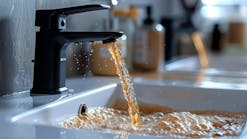A few weeks ago, the local electric utility visited my apartment building to give the residents free efficiency upgrades. The focus was not solely energy, however—in addition to replacing all of the building’s standard light bulbs with energy-efficient ones, the company installed free water-efficient faucets and showerheads in each unit.
I was pleasantly surprised to find these new additions upon entering my apartment that day—they are an easy way I can help conserve energy and water while going about my everyday tasks. While I have always been conscious of saving energy, my new faucet has helped me consider how I can conserve water as well.
Just as consumers are becoming more aware of contaminants and other water quality issues, they are also becoming more aware of water efficiency and sustainability. From the increasing popularity of rain gardens and rain barrels to the growing presence of programs like the U.S. Environmental Protection Agency’s (EPA) WaterSense, this topic is coming to the forefront in the U.S.
The WaterSense program works to raise Americans’ awareness of this issue. According to Veronica Blette, chief of the program and subject of this month’s Industry Insight (“Sensible Savings,” page 34), more than 3,700 products have been certified by WaterSense as water efficient. The program recently celebrated its first WaterSense-labeled homes—four new houses in Roseville, Calif., that EPA estimates will save families approximately 10,000 gal of water and $100 in utility bills per year.
Adding to the issue’s urgency are reports of shrinking water supplies in the U.S. Last year, news outlets reported that Lake Mead, the Colorado River reservoir behind the Hoover Dam and a major drinking water source in the West, dropped to its lowest level since 1937. Further drops could cause water shortages in Nevada. The New York Times recently reported about scientists who use satellite technology to measure groundwater levels around the globe (“Groundwater Depletion is Detected From Space,” May 30, 2011). Using data from two satellites, they have found that groundwater reservoir supplies are dwindling, especially in areas like the Sacramento-San Joaquin Valley in California.
It does not take a whole WaterSense-certified home to do your part in terms of conserving water—according to Blette, there are small steps that anyone can take to be more efficient, like turning off the tap while brushing your teeth. Just as you educate customers on the water quality issues that affect their homes, you have the opportunity to inform them about ways they can become more water efficient. Whether you recommend the installation of water-efficient appliances and fixtures or provide tips on ways to reduce water use, customers can value you as a source of information for all the water issues affecting their homes.
Top Projects
Nominations are now being accepted for the 2011 WQP Water Quality Top Projects. The inaugural 2010 award program was a success, recognizing a number of innovative water quality projects in the December 2010 Reference Guide issue. Did you recently complete a challenging installation? Go to www.wqpmag.com and fill out our online form to nominate your residential or commerical/industrial projects for this year’s awards. Entries must be recieved by Aug. 26, 2011, and winners will be featured in the 2011 WQP Reference Guide issue in December.
Photo: FreeImages.com/Julia Freeman-Woolpert
Download: Here



